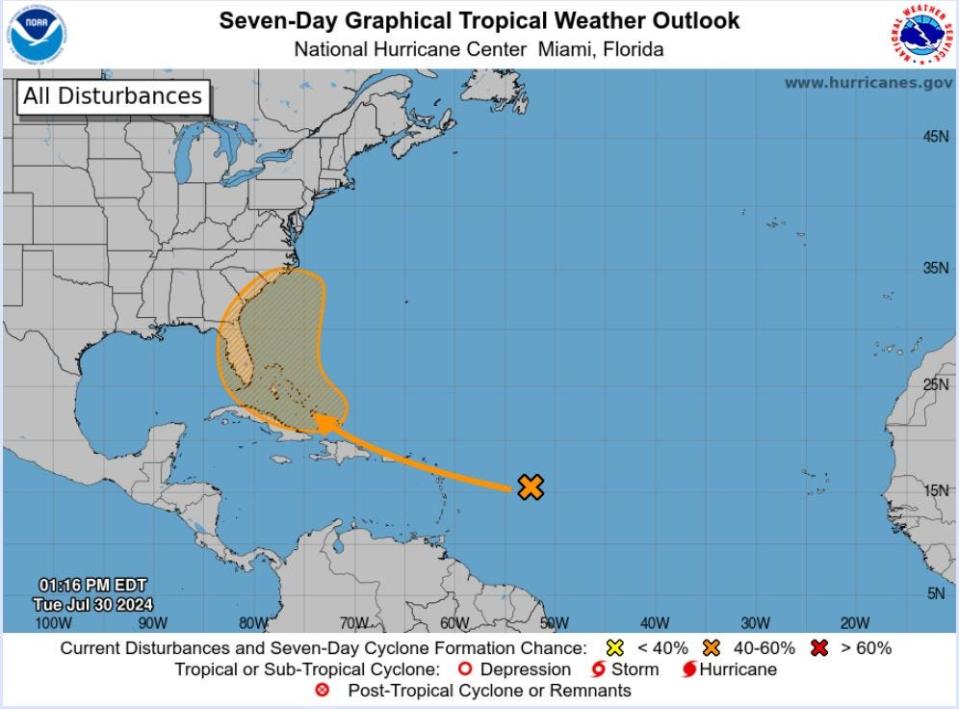Hurricane center increases odds that tropical system will develop this week to 60%
The odds of a tropical depression or named storm forming near Florida increased on Tuesday and meteorologists recommended people in the southeastern U.S. keep an eye on the forecast as a large and sloppy tropical wave moves west.
The National Hurricane Center gave the wave, which was several hundred miles east of the Lesser Antilles, a 60% chance of developing over the next seven days with the warmer waters of the southwestern Atlantic Ocean beckoning.
Development for now is being stymied by dry Saharan air, but forecasters believe the system will soon break free of that restriction. Where exactly that will happen and how organized the system could get is still uncertain.
On Tuesday, the NHC was predicting a depression could form later this week in an area from the southeastern Bahamas through the Florida Peninsula and up into waters off of Georgia and South Carolina.
More: Hurricane season 2024: More than 1 million new Florida residents may not understand storm prep
If a tropical storm forms, meaning it has a closed center of circulation and sustained wind speeds of at least 39 mph, it would be named Debby. Following Debby, the next two names on the 2024 hurricane list are Ernesto and Francine.
National Weather Service meteorologists in Miami are also watching the tropical wave over the central Atlantic Ocean, and reiterated that there is a big gap between weather models as far as what its future holds.
More "disorganized" solutions favor a western track into the Gulf of Mexico, which may include a soggy passage over Florida. Models that show the system consolidating and becoming better organized favor it going more easterly with some taking it well east of the Florida Peninsula as it rides around the western edge of the Bermuda High.

Robert Garcia, a meteorologist in the NWS Miami office, said he hopes to have a better idea of what is coming — or not — by Thursday.
"It's fair to say we could have a tropical depression in our vicinity some point late week into early next week," Garcia said. "We can't rule out the potential for a rainy weekend. Things right now look like we could be somewhat wet."
Also, NWS Miami forecasters emphasized that even if a more organized storm develops, it doesn't necessarily imply greater impacts to South Florida. If dry air wraps into the storm, it could put South Florida on the drier west side of the system. At the same time, a messy meandering system could result in more rainfall.
More: Hurricane Beryl's rapid intensification has emergency managers mulling survival timelines
"Like everything else this time of year, there will be patches of less favorable and more favorable environments," Garcia said.
While scattered and sometimes heavy showers hit parts of South Florida Monday and Tuesday, a burst of Saharan air on Wednesday is expected to reduce rain chances and increase temperatures. The official forecast for West Palm Beach calls for a 20% chance of rain with a high of 93 degrees. Heat index, or "feels like" temperatures could reach as high as 106.
Rain would be welcomed in some parts of Palm Beach County. Through Monday, Palm Beach International Airport was down 3.34 inches of rain for the month of July making it the 14th driest July in records dating back 131 years.
Kimberly Miller is a journalist for The Palm Beach Post, part of the USA Today Network of Florida. She covers real estate and how growth affects South Florida's environment. Subscribe to The Dirt for a weekly real estate roundup. If you have news tips, please send them to kmiller@pbpost.com. Help support our local journalism; subscribe today.
This article originally appeared on Palm Beach Post: National Hurricane Center increases chances system will develop in area near Florida

